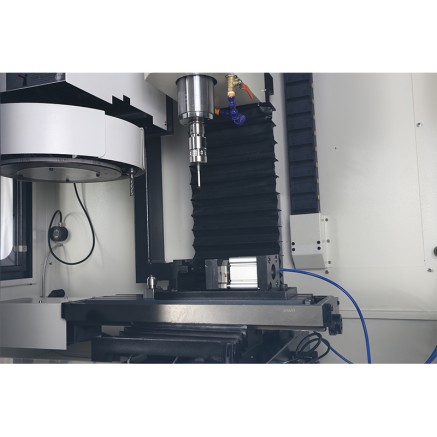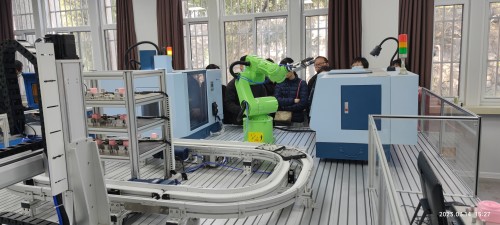Blog
Xendoll has 22 years of experience in the production of small machine tools. We will help you choose the suitable machine and share our experience in CNC machining with you.
 Nov 05, 2024
Nov 05, 2024
 Xendoll
Xendoll
 1015
1015
In modern manufacturing, 3-axis CNC machines (3-Axis CNC Machining) are widely used for machining a variety of parts, particularly for small, high-precision components. Although 3-axis machines are relatively simple in structure, they are highly capable and versatile. However, during machining, it is crucial to address cooling and lubrication issues to prevent overheating of the workpiece or excessive tool wear, which can significantly affect both machining quality and efficiency. This article explores the importance of cooling and lubrication in 3-axis CNC machining and how to optimize these systems to avoid common problems like overheating and tool wear.

3-axis CNC machines are the most common type of CNC machine, typically featuring linear motion along three axes: X, Y, and Z. They are highly effective for a wide range of machining tasks and are especially suited for small-batch, high-precision production. While they are widely used, their machining process generates significant cutting forces and heat, which makes proper cooling and lubrication essential. Without these, issues such as thermal distortion, tool wear, and reduced cutting efficiency can arise.
Cooling Function
High-speed cutting generates substantial heat, especially when machining materials. If this heat is not dissipated, it can lead to several issues:
Coolant is used to absorb the heat generated in the cutting zone, helping to keep both the workpiece and the tool within a safe temperature range, thus maintaining machining accuracy and preventing damage.
Workpiece Thermal Deformation: Excessive heat can cause thermal expansion of the workpiece, which may result in dimensional inaccuracies. Temperature control is critical in precision machining, especially when working with high-hardness materials.
Tool Thermal Damage: Tools exposed to high temperatures for extended periods can lose hardness, leading to reduced tool life.
Increased Cutting Forces: Higher temperatures can reduce the material’s machinability, increasing cutting forces and potentially leading to more rapid tool wear and increased machine load.
Lubrication Function
Friction between the cutting tool and the workpiece is a significant contributor to tool wear. Proper lubrication helps form a thin film between the tool and the workpiece, reducing direct contact and minimizing friction, which in turn extends tool life.
Reducing Friction and Wear: Lubricants reduce the friction between the tool and the workpiece, lowering the wear rate of the tool.
Improving Cutting Efficiency: Lubricants reduce cutting forces and cutting temperatures, making machining more efficient and helping to achieve higher-quality surface finishes.
Preventing Heat Damage: Lubrication helps mitigate thermal damage to both the tool and the workpiece by reducing heat buildup in the cutting zone.
Desktop-sized 3-axis CNC machines, commonly used for small part production, require cooling and lubrication systems that are simple, cost-effective, and easy to maintain, while still being capable of handling the thermal and frictional challenges posed by machining. Below are several common cooling and lubrication methods used in 3-axis CNC machining.
External Spray Cooling
External spray cooling is one of the most commonly used methods for cooling in desktop 3-axis CNC machines. Coolant is sprayed directly onto the cutting zone, helping to absorb heat and keep the workpiece and tool temperature within an acceptable range. Spray cooling systems typically consist of pumps, nozzles, and piping, and they are relatively easy to install and maintain.
Advantages:
Disadvantages:
Since coolant is not directly applied to the tool, the cooling efficiency may be lower compared to more advanced systems, making it less suitable for heavy-duty machining.
Simple structure and easy to install.
Efficient at lowering the temperature of the cutting zone and reducing thermal damage.
Oil-Mist Cooling
Oil-mist cooling combines oil-based lubricants with compressed air to create a fine mist that is directed onto the cutting zone. This method not only cools the cutting area but also lubricates the tool, reducing wear and improving surface finish. Oil-mist cooling is especially useful for high-precision tasks that require both cooling and lubrication.
Advantages:
Disadvantages:
Requires specialized equipment and maintenance, which may increase costs.
Provides effective lubrication and cooling simultaneously, extending tool life.
Helps reduce friction, which enhances machining efficiency.
Internal Cooling System
Some advanced desktop 3-axis CNC machines may feature internal cooling systems where coolant is channeled directly through the tool to the cutting edge. This method ensures that the coolant is applied directly to the cutting zone, providing efficient heat dissipation, especially during heavy cutting or deep-hole drilling.
Advantages:
Disadvantages:
Requires specialized tooling with internal coolant channels and a higher level of coolant flow and pressure control.
Direct application of coolant to the cutting area provides more efficient cooling.
Helps maintain temperature stability, improving machining accuracy.
Dry Cutting
In some cases, 3-axis CNC machines may perform dry cutting, where no coolant or lubricant is used. This method relies solely on the material properties of the tool and workpiece to carry out the cutting operation. Dry cutting is typically used when precise temperature control is not critical or when using self-lubricating tools.
Advantages:
Disadvantages:
High cutting temperatures can cause excessive tool wear, making it unsuitable for precision or high-load cutting tasks.
No coolant or lubricant is required, reducing environmental impact and cleaning costs.
Reduces the need for coolant maintenance.

Choosing the Right Coolant
The selection of coolant depends on the material being machined, the cutting conditions, and the machine type. Common coolants include water-soluble coolants and oil-based coolants. Water-soluble coolants are typically used for general machining, while oil-based coolants are more suitable for high-load, high-temperature cutting, especially when machining hard materials.
Selecting the Right Lubricant
The lubricant must have good lubrication properties, as well as characteristics such as oxidation resistance, extreme pressure resistance, and a high viscosity index. The right lubricant will help reduce cutting forces, extend tool life, and prevent excessive heat buildup.
In 3-axis CNC machining, effective cooling and lubrication are essential to maintaining machining quality and improving production efficiency. By selecting the appropriate coolant and lubricant, and choosing the right cooling method, manufacturers can prevent overheating of workpieces, minimize tool wear, and improve overall machining performance. As technology advances, cooling and lubrication systems will continue to evolve, offering even better solutions for high-precision machining tasks and extending the capabilities of 3-axis CNC machines.



 Show all our samples
Show all our samples
 Provide you with a free quote
Provide you with a free quote
 Answer all the questions you may have
Answer all the questions you may have
 Guided installation and other options
Guided installation and other options